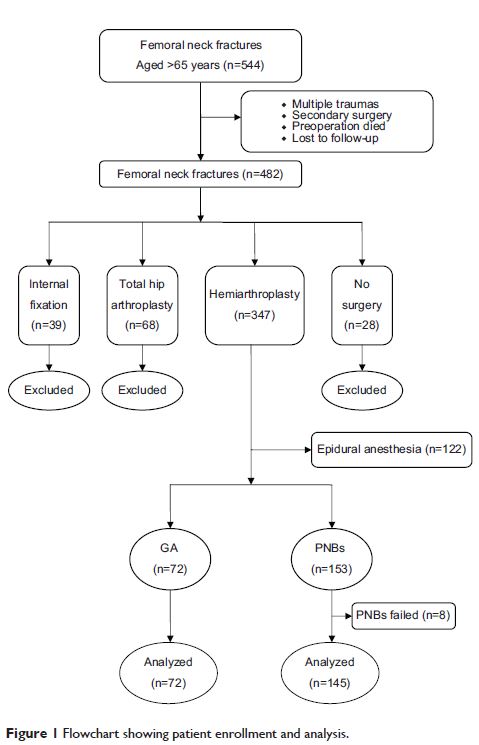9 0 8 0 2
论文已发表
注册即可获取德孚的最新动态
IF 收录期刊
- 2.6 Breast Cancer (Dove Med Press)
- 3.9 Clin Epidemiol
- 3.3 Cancer Manag Res
- 3.9 Infect Drug Resist
- 3.6 Clin Interv Aging
- 4.8 Drug Des Dev Ther
- 2.8 Int J Chronic Obstr
- 8.0 Int J Nanomed
- 2.3 Int J Women's Health
- 3.2 Neuropsych Dis Treat
- 4.0 OncoTargets Ther
- 2.2 Patient Prefer Adher
- 2.8 Ther Clin Risk Manag
- 2.7 J Pain Res
- 3.3 Diabet Metab Synd Ob
- 4.3 Psychol Res Behav Ma
- 3.4 Nat Sci Sleep
- 1.9 Pharmgenomics Pers Med
- 3.5 Risk Manag Healthc Policy
- 4.5 J Inflamm Res
- 2.3 Int J Gen Med
- 4.1 J Hepatocell Carcinoma
- 3.2 J Asthma Allergy
- 2.3 Clin Cosmet Investig Dermatol
- 3.3 J Multidiscip Healthc

在中国老年髋部骨折患者中,进行周围神经阻滞麻醉与全身麻醉的比较结果
Authors Liu JL, Wang XL, Gong MW, Mai HX, Pei SJ, Yuan WX, Zhang H
Published Date May 2014 Volume 2014:8 Pages 651—659
DOI http://dx.doi.org/10.2147/PPA.S61903
Received 5 February 2014, Accepted 21 March 2014, Published 7 May 2014
Background: Geriatric patients undergoing hemiarthroplasty for hip fractures have unacceptably high rates of postoperative complications and mortality. Whether anesthesia type can affect the outcomes has still been inconclusive.
Objectives: We compared general anesthesia (GA) and peripheral nerve blocks (PNBs) on postoperative complications and mortality in elderly patients with femoral neck fractures (FNF) undergoing hemiarthroplasty.
Materials and methods: This retrospective study involved data collection from an electronic database. Two hundred and seventeen patients underwent hemiarthroplasty for FNF between January 2008 and December 2012 at the Chinese People's Liberation Army General Hospital. Data on mortality within in-hospital, 30-day, and 1-year, complications, comorbidities, blood loss and transfusion, operative time, postoperative hospital length of stay, intensive care unit admission, and hospital charge were collected and analyzed. Univariate and multivariate Cox regression analyses of all variables were used for 30-day and 1-year mortality.
Results: Seventy-two patients receiving GA and 145 receiving PNBs were eventually submitted and analyzed. Mortality was 6.9%, 14.7%, and 23.5% at in-hospital, 30-day, and 1-year, respectively postoperatively, while mortality and cardiovascular complications did not differ between the two anesthetic techniques. Preoperative comorbidities and intraoperative parameters were not statistically different except that patients receiving GA were more likely to have dementia (Ⅹ 2=10.45, P =0.001). The most common complications were acute cardiovascular events, electrolyte disturbances, and delirium. Postoperative acute respiratory events and hypoxemia both were also common, but no differences were found between groups (Ⅹ 2=0.68, P =0.410; Ⅹ 2=3.42, P =0.065, respectively). Key factors negatively influencing mortality included: age, male gender, American Society of Anesthesiologists status, dementia, perioperative cardiovascular events and respiratory events, postoperative stroke, myocardial infarction, and hypoxia.
Conclusion: Mortality and postoperative complications are not statistically significantly different between PNBs and GA among eldery patients undergoing hemiarthroplasty for FNF.
Keywords: femoral neck fractures, elderly, mortality, postoperative complications
